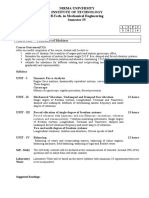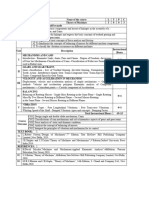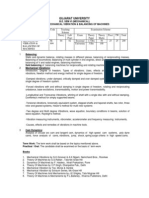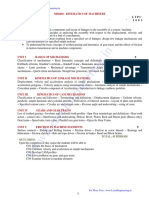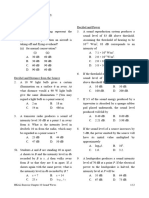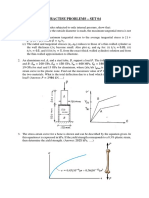ME304 Dynamics of Machinery
ME304 Dynamics of Machinery
Uploaded by
SojuCopyright:
Available Formats
ME304 Dynamics of Machinery
ME304 Dynamics of Machinery
Uploaded by
SojuOriginal Description:
Copyright
Available Formats
Share this document
Did you find this document useful?
Is this content inappropriate?
Copyright:
Available Formats
ME304 Dynamics of Machinery
ME304 Dynamics of Machinery
Uploaded by
SojuCopyright:
Available Formats
Course code Course Name L-T-P- Year of
Credits Introduction
ME304 DYNAMICS OF MACHINERY 2-1-0-3 2016
Prerequisite: ME301 Mechanics of Machinery
Course Objectives:
To impart knowledge on force analysis of machinery, balancing of rotating and
reciprocating masses, Gyroscopes, Energy fluctuation in Machines.
To introduce the fundamentals in vibration, vibration analysis of single degree of
freedom systems.
To understand the physical significance and design of vibration systems with desired
conditions
Syllabus
Force analysis of machinery - static and dynamic force analysis of plane motion mechanisms.
Flywheel analysis - static and dynamic balancing - balancing of rotating masses, gyroscopic couples.
Vibrations – free vibrations of single degree freedom systems, damping, forced vibration, torsional
vibration.
Expected outcome:
The students will be able to
1. Develop the design and practical problem solving skills in the area of mechanisms
2. Understand the basics of vibration and apply the concepts in design problems of
mechanisms.
Text Books:
1. Ballaney P.L. Theory of Machines, Khanna Publishers,1994
2. S. S. Rattan, Theory of Machines, Tata McGraw Hill, 2009
3. V. P. Singh, Theory of Machines, Dhanpat Rai,2013
References :
1. E. Wilson, P. Sadler, Kinematics and Dynamics of Machinery, Pearson Education, 2003
2. Ghosh, A. K. Malik, Theory of Mechanisms and Machines, Affiliated East West Press,
2003
3. H. Myskza, Machines and Mechanisms Applied Kinematic Analysis, Pearson Education,
4e, 2012
4. Holowenko, Dynamics of Machinery, John Wiley, 1995
5. J. E. Shigley, J. J. Uicker, Theory of Machines and Mechanisms, McGraw Hill,1995
6. W.T.Thompson, Theory of vibration, Prentice Hall,1997
Course Plan
End
Module Contents Hours Sem.
Exam
Marks
Introduction to force analysis in mechanisms - static force analysis
(four bar linkages only) - graphical methods 4
I 15%
Matrix methods - method of virtual work - analysis with sliding and
pin friction 3
Dynamic force analysis: Inertia force and inertia torque. D’Alemberts
principle, analysis of mechanisms (four bar linkages only), 4
II equivalent dynamical systems 15%
Force Analysis of spur- helical - bevel and worm gearing 3
FIRST INTERNAL EXAM
Flywheel analysis - balancing - static and dynamic balancing -
balancing of masses rotating in several planes 4
III 15%
Balancing of reciprocating masses - balancing of multi-cylinder in
line engines - V engines - balancing of machines 3
Gyroscope – gyroscopic couples
3
Gyroscopic action on vehicles-two wheelers, four wheelers, air planes
IV 15%
and ships. Stability of an automobile – stability of a two wheel vehicle
4
–Stabilization of ship.
SECOND INTERNAL EXAM
Introduction to vibrations – free vibrations of single degree freedom
systems – energy Method 2
Undamped and damped free vibrations – viscous damping – critical
V damping - logarithmic decrement - Coulomb damping – harmonically 3 20%
excited vibrations
Response of an undamped and damped system – beat phenomenon -
transmissibility 2
Whirling of shafts – critical speed - free torsional vibrations – self
excitation and stability analysis - vibration control - vibration isolation 4
VI – vibration absorbers 20%
.Introduction to multi-degree freedom systems - vibration
measurement - accelerometer – seismometer – vibration exciters 3
END SEMESTER EXAM
Question Paper Pattern
Maximum marks: 100 Time: 3 hrs
The question paper should consist of three parts
Part A
There should be 2 questions each from module I and II
Each question carries 10 marks
Students will have to answer any three questions out of 4 (3X10 marks =30 marks)
Part B
There should be 2 questions each from module III and IV
Each question carries 10 marks
Students will have to answer any three questions out of 4 (3X10 marks =30 marks)
Part C
There should be 3 questions each from module V and VI
Each question carries 10 marks
Students will have to answer any four questions out of 6 (4X10 marks =40 marks)
Note: Each question can have a maximum of four sub questions, if needed.
You might also like
- ME211 Mechanics of Solids and Mechanics of MachinesDocument2 pagesME211 Mechanics of Solids and Mechanics of Machinesnandan144No ratings yet
- ME214 Theory of MachinesDocument2 pagesME214 Theory of Machinesnandan144No ratings yet
- ME374 Theory of VibrationsDocument3 pagesME374 Theory of VibrationsJaseel Hassan KNo ratings yet
- ME301 Mechanics of MachineryDocument2 pagesME301 Mechanics of MachineryVishnu Mohan M SNo ratings yet
- Nirma University Institute of Technology B.Tech. in Mechanical Engineering Semester IVDocument2 pagesNirma University Institute of Technology B.Tech. in Mechanical Engineering Semester IVKartik aminNo ratings yet
- DoM Syllabus 05082023Document2 pagesDoM Syllabus 05082023Vivek Reddy MudireddyNo ratings yet
- Me8594-Dynamics of Machines - Part A and Part B Questions and AnswersDocument116 pagesMe8594-Dynamics of Machines - Part A and Part B Questions and AnswersSYLVIA ANITANo ratings yet
- Dynamics of Machinery - 1Document3 pagesDynamics of Machinery - 1madgceNo ratings yet
- Course Objectives:: Me3262:Dynamics of MachinesDocument4 pagesCourse Objectives:: Me3262:Dynamics of Machinesgiriaj kokareNo ratings yet
- Mee301 Dynamics-Of-machinery Eth 1.10 Ac26Document2 pagesMee301 Dynamics-Of-machinery Eth 1.10 Ac26yashvantNo ratings yet
- 081 - ME8594 Dynamics of Machines - Anna University 2017 Regulation Syllabus PDFDocument2 pages081 - ME8594 Dynamics of Machines - Anna University 2017 Regulation Syllabus PDFKrish NarayananNo ratings yet
- 22MT4203 TomDocument1 page22MT4203 TomR.MADHU SUDHANAN HICET STAFF EIENo ratings yet
- Me8594 SyllabusDocument2 pagesMe8594 Syllabussara vanaNo ratings yet
- Dom 3151911Document3 pagesDom 3151911Bhagirathsinh ZalaNo ratings yet
- Dynamics of Machinery Syllabus RC 2019-20Document4 pagesDynamics of Machinery Syllabus RC 2019-20Nishant MayekarNo ratings yet
- Mechanical Vibrations & Balancing of MachinesDocument1 pageMechanical Vibrations & Balancing of Machinesjaved alamNo ratings yet
- Lectures Notes On: Machine Dynamics IIDocument145 pagesLectures Notes On: Machine Dynamics IIHaider NeamaNo ratings yet
- ME 8594 Dynamics of MachinesDocument2 pagesME 8594 Dynamics of Machinesjamunaa83No ratings yet
- Kinematics of Machines III Sem Syllabus 01092021Document4 pagesKinematics of Machines III Sem Syllabus 01092021Milind KshirsagarNo ratings yet
- TE Syllabus Mech PDFDocument40 pagesTE Syllabus Mech PDFSanket JadhavNo ratings yet
- DOM Syllabus PDFDocument2 pagesDOM Syllabus PDFAnilNo ratings yet
- DOM Syllabus PDFDocument2 pagesDOM Syllabus PDFAnilNo ratings yet
- Mech Engg 4-1 CS & Syllabus - UG - R20-5-6Document2 pagesMech Engg 4-1 CS & Syllabus - UG - R20-5-6sri.nanilapNo ratings yet
- 10me201 Mechanics of Machines - Ii Credits: 4:0:0 Course ObjectivesDocument1 page10me201 Mechanics of Machines - Ii Credits: 4:0:0 Course ObjectivesManda Ramesh BabuNo ratings yet
- Gujarat Technological University: Mechanical Engineering (19) Subject CodeDocument3 pagesGujarat Technological University: Mechanical Engineering (19) Subject CodeTanmay BhalodiNo ratings yet
- EM MOD1-Ktunotes - inDocument37 pagesEM MOD1-Ktunotes - inIndra Pratap SengarNo ratings yet
- 6 Sem SyllabusDocument7 pages6 Sem SyllabusAjinkya NawghareNo ratings yet
- Kom Lecture NotesDocument163 pagesKom Lecture NotesgvnagamaniNo ratings yet
- Engineering Mechanics (9011)Document6 pagesEngineering Mechanics (9011)kallepalliNo ratings yet
- Syllabus - 3rd & 4thmechanical EngineeringDocument35 pagesSyllabus - 3rd & 4thmechanical EngineeringSalman KhanNo ratings yet
- Syllabus DOMDocument3 pagesSyllabus DOMThamizh Selvan SNo ratings yet
- Kinematics of Machinery: II B.Tech IV SemesterDocument2 pagesKinematics of Machinery: II B.Tech IV SemesterPraveen KumarNo ratings yet
- Dynamics of MachineryDocument2 pagesDynamics of MachineryBhavesh PipaliyaNo ratings yet
- Me6401 KomDocument128 pagesMe6401 KomThomas LafontaineNo ratings yet
- M.tech Mechanical (Design) Sem IDocument11 pagesM.tech Mechanical (Design) Sem IkbhattacNo ratings yet
- Mech-Vii-Mechanical Vibrations NotesDocument86 pagesMech-Vii-Mechanical Vibrations NotesHOD MEDNo ratings yet
- Ae 6602 SyllabusDocument1 pageAe 6602 SyllabusvairamNo ratings yet
- MEE2004 Mechanics-Of-Machines ETH 1.1 AC40Document3 pagesMEE2004 Mechanics-Of-Machines ETH 1.1 AC40orionNo ratings yet
- Gujarat Technological University: W.E.F. AY 2018-19Document3 pagesGujarat Technological University: W.E.F. AY 2018-19Bhavesh Patel100% (1)
- Kinematics of Machinery: Lecture NotesDocument3 pagesKinematics of Machinery: Lecture NotesPraveen KumarNo ratings yet
- 5th Sem Scheme Mechanical EngineeringDocument26 pages5th Sem Scheme Mechanical EngineeringYogesh MokaddamNo ratings yet
- Vardhaman College of Engineering, Hyderabad: Iii B.Tech I Semester Course StructureDocument2 pagesVardhaman College of Engineering, Hyderabad: Iii B.Tech I Semester Course StructureHod of ME PRRMNo ratings yet
- Gujarat Technological University: W.E.F. AY 2018-19Document3 pagesGujarat Technological University: W.E.F. AY 2018-19error400.hNo ratings yet
- ME115 Dynamics of Machinery: ND TH THDocument1 pageME115 Dynamics of Machinery: ND TH THVipulNo ratings yet
- Mechanical Vibration 2Document2 pagesMechanical Vibration 2Nizar MachmudNo ratings yet
- Vibration PDFDocument2 pagesVibration PDFalemker abebawNo ratings yet
- 91 Senate Approved Courses Scheme & Syllabus For B.E. Mechanical Engg. (2016)Document2 pages91 Senate Approved Courses Scheme & Syllabus For B.E. Mechanical Engg. (2016)VINAYAK SHARMANo ratings yet
- DOM Course Design Policy 2022Document12 pagesDOM Course Design Policy 2022Savio B CardosoNo ratings yet
- Gujarat Technological UniversityDocument3 pagesGujarat Technological UniversityBhavesh PatelNo ratings yet
- EMG 4212 CN 1Document5 pagesEMG 4212 CN 1nyamairkNo ratings yet
- KDOM Syllabus_d58917cc2649129bd40e272ef26c74d0Document2 pagesKDOM Syllabus_d58917cc2649129bd40e272ef26c74d0Kartik GaikwàdNo ratings yet
- ME6401 SCAD MSM by EasyEngineering - Net 1Document122 pagesME6401 SCAD MSM by EasyEngineering - Net 1shankar0% (1)
- ME8492 Kinematics of Machinery 03 - by LearnEngineering - inDocument76 pagesME8492 Kinematics of Machinery 03 - by LearnEngineering - inPrasanna SekarNo ratings yet
- Modern Anti-windup Synthesis: Control Augmentation for Actuator SaturationFrom EverandModern Anti-windup Synthesis: Control Augmentation for Actuator SaturationRating: 5 out of 5 stars5/5 (1)
- Multiple Models Approach in Automation: Takagi-Sugeno Fuzzy SystemsFrom EverandMultiple Models Approach in Automation: Takagi-Sugeno Fuzzy SystemsNo ratings yet
- New Directions in Dynamical Systems, Automatic Control and Singular PerturbationsFrom EverandNew Directions in Dynamical Systems, Automatic Control and Singular PerturbationsNo ratings yet
- Ghazi Kaoud - Force Fan Carts SEDocument6 pagesGhazi Kaoud - Force Fan Carts SEghazi.a.kaoudNo ratings yet
- Gabriel Eugenio CHAO, Dispersive Surface Acoustic Waves in Poroelastic MediaDocument143 pagesGabriel Eugenio CHAO, Dispersive Surface Acoustic Waves in Poroelastic MediaOlegNo ratings yet
- Super Conductivity NotesDocument2 pagesSuper Conductivity Notesvasudevan m.vNo ratings yet
- Symbols in PhysicsDocument4 pagesSymbols in PhysicsAzura AzizNo ratings yet
- 10 - Sound Waves - ExerciseDocument13 pages10 - Sound Waves - Exercisekenchan0810.kcNo ratings yet
- Structural Sections BS4Document42 pagesStructural Sections BS4ahmadove1No ratings yet
- Sofialidis HPC Ansys Fluent 01Document18 pagesSofialidis HPC Ansys Fluent 01fffNo ratings yet
- ANSYS Explicit Dynamics - Ashish Jaiswal PDFDocument57 pagesANSYS Explicit Dynamics - Ashish Jaiswal PDFhamedNo ratings yet
- RC Beam Design (Cantilever)Document7 pagesRC Beam Design (Cantilever)api-1975359867% (3)
- Newton ApplicationsDocument22 pagesNewton ApplicationsAyham SmadiNo ratings yet
- CFD Comparison of Buoyant and Non-Buoyant JetDocument58 pagesCFD Comparison of Buoyant and Non-Buoyant JetKaffelNo ratings yet
- Lecture Notes On Thermodynamics. Joseph M. PowersDocument383 pagesLecture Notes On Thermodynamics. Joseph M. PowersGustavo CoronelNo ratings yet
- Universal GravitationDocument55 pagesUniversal GravitationfangirltonNo ratings yet
- 076BAS030 PritamDocument9 pages076BAS030 PritamPritam SahNo ratings yet
- Water Bottle Flip LabDocument11 pagesWater Bottle Flip LabjjNo ratings yet
- Experiment 4 Ideal Fluid FlowDocument16 pagesExperiment 4 Ideal Fluid FlowGiea Patricze ArcaNo ratings yet
- Static Force AnalysisDocument56 pagesStatic Force Analysissri kiranNo ratings yet
- Yes SRDocument5 pagesYes SRSecret SecretNo ratings yet
- 0625 w15 Ms 33Document7 pages0625 w15 Ms 33Hany ElGezawyNo ratings yet
- Worksheet - Pressure and Thermal PhysicsDocument11 pagesWorksheet - Pressure and Thermal Physicshassanpopstar112234No ratings yet
- EE C222/ ME C237 - Spring'18 - Lecture 4 Notes: Murat Arcak January 29 2018Document5 pagesEE C222/ ME C237 - Spring'18 - Lecture 4 Notes: Murat Arcak January 29 2018SBNo ratings yet
- Part-1: Subjective Questions: KinematicsDocument27 pagesPart-1: Subjective Questions: KinematicsB AbhinavNo ratings yet
- Practise Problems Set04Document5 pagesPractise Problems Set04rohit kumarNo ratings yet
- Opening Shock Calculations of A ParachuteDocument15 pagesOpening Shock Calculations of A ParachuteSuleyman Ertugrul SahinNo ratings yet
- Civil Engineering: Ese Topicwise Objective SolvedDocument7 pagesCivil Engineering: Ese Topicwise Objective SolvedPrabhakar S ChauhanNo ratings yet
- CM To QMDocument37 pagesCM To QMnNo ratings yet
- EASE 4 Grade 11Document22 pagesEASE 4 Grade 11Fauziyah ZiaNo ratings yet
- Chapter 1-ElasticityDocument34 pagesChapter 1-ElasticityGüneş DilberNo ratings yet
- Phy Assignment 2Document4 pagesPhy Assignment 2Amanjot KaurNo ratings yet
- Shumar Ah 16Document66 pagesShumar Ah 16shahidmhmood786No ratings yet




